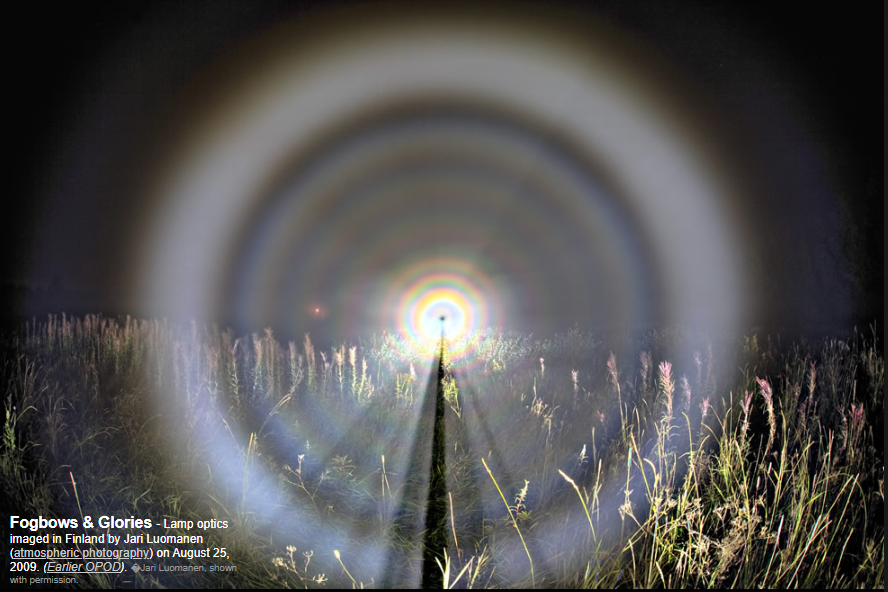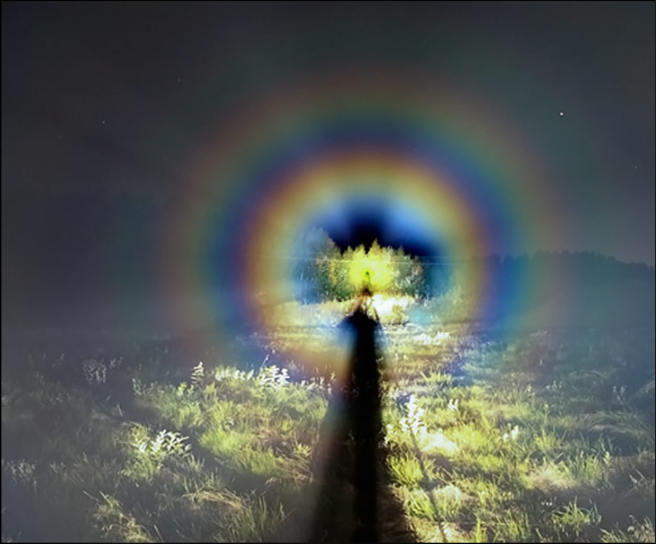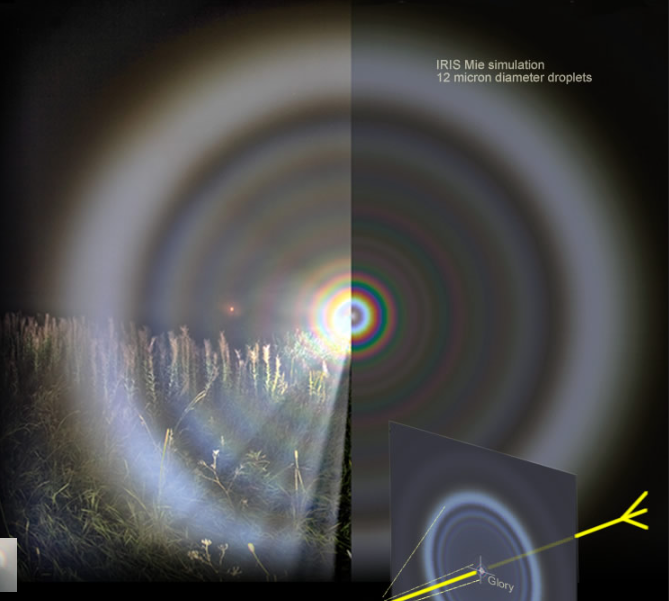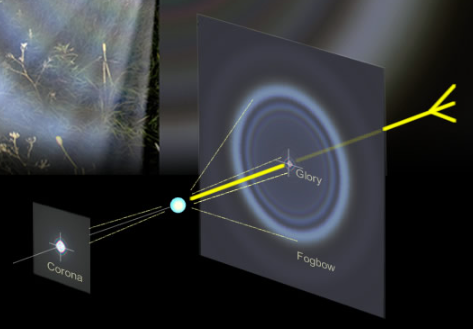Spheres of light
Spheres of Light: A Fascinating Display of Atmospheric Optics
Atmospheric optics never fails to amaze us with its stunning displays of light phenomena. One such captivating spectacle is the formation of "spheres of light," which include fogbows, glories, and diffraction patterns. These mesmerizing optical phenomena occur when light interacts with tiny water droplets suspended in the air. In this article, we will delve deeper into the science behind these spheres of light and explore their intricate beauty.
The Formation of Fogbows and Glories
Fogbows, also known as white rainbows, are ethereal arcs of light that resemble a traditional rainbow but with a more subtle and colorless appearance. Unlike rainbows that form through the refraction and reflection of sunlight on raindrops, fogbows are created by the diffraction of light on tiny water droplets present in fog or mist. The droplets in a fogbow are much smaller than raindrops, resulting in a diffraction pattern with less color saturation.
At the center of a fogbow lies a primary arc, which is almost colorless. As the droplet size increases, the outer edges of the fogbow become adorned with shades of straw and red, while the inner edges display hues of blue and violet. Additionally, a faint secondary arc may appear beyond the primary fogbow, resulting from two internal reflections within the water droplets.
Opposite to the light source, you can often observe a glory. A glory is a series of concentric rings of colored light that surround the shadow of an observer on cloud or fog. Glories are formed by a different process called "backscattering," where light is scattered back towards the observer due to the diffraction and interference of light waves with the droplets.
The Enigmatic Diffraction Patterns
In addition to fogbows and glories, the phenomenon of diffraction patterns adds another layer of intrigue to the spheres of light. When intense light, such as that emitted by a high-intensity discharge (HID) lamp, passes through a dilute nighttime fog, the individual water droplets scatter the light, creating a massive diffraction pattern. This pattern consists of bright rings that gradually decrease in color intensity as they extend outward.
The diffraction pattern components may have distinct names, but they are all continuous parts of a spherical light scattering phenomenon. The brightest ring in the diffraction pattern can span an impressive diameter of 70-80 degrees. To capture the entire scene, a wide-angle lens is often required.
Understanding the Science behind Spheres of Light
To gain a deeper understanding of the intricate details within spheres of light, scientists have conducted calculations and simulations using Mie scattering theory. Mie scattering is a mathematical model that describes the interaction between light and spherical particles, such as water droplets.
These calculations have revealed that the fine structure and multiple rings observed in diffraction patterns indicate the presence of droplets with similar sizes. By comparing the fogbow and glory with Mie scattering calculations, researchers have found a reasonable fit between the observed phenomena and theoretical predictions. However, it's important to note that these calculations assume parallel light, whereas the light emitted by a lamp is diverging. Therefore, exact matches should not be expected.
Capturing the Beauty of Spheres of Light
Photographers and enthusiasts around the world have been captivated by the ethereal beauty of spheres of light. To capture these optical phenomena, photographers often position themselves with the light source behind them, pointing in the opposite direction. This allows for the optimal scattering and diffraction of light by the water droplets in the air.
Using wide-angle lenses, photographers can encompass the entire scene, showcasing the intricate patterns and delicate hues present within fogbows, glories, and diffraction patterns. The interplay between light and water droplets creates a mesmerizing display of nature's artistry, reminding us of the wonders that exist within our atmosphere.
Conclusion
Spheres of light, including fogbows, glories, and diffraction patterns, offer a captivating glimpse into the enchanting world of atmospheric optics. These phenomena occur when light interacts with tiny water droplets suspended in the air, resulting in ethereal displays of color and pattern. Through the exploration of scientific theories and the artistic endeavors of photographers, we can gain a deeper appreciation for the delicate beauty and complexity found within spheres of light. So, the next time you find yourself in the midst of fog or mist, take a moment to look up and marvel at the enchanting spheres of light that grace our skies.

Fogbows & Glories - Lamp optics imaged in Finland by Jari Luomanen (atmospheric photography) on August 25, 2009. (Earlier OPOD). �Jari Luomanen, shown with permission.

Droplets of a dilute night-time fog have individually scattered the light of an intensely bright HID (high intensity discharge) lamp to form a huge diffraction pattern. The brightest ring is 70-80� in diameter and the whole scene demanded a very wide angle lens.
The lamp was behind the camera which was pointing away from it in the opposite direction.
The diffraction pattern components have individual names but they are all continuous parts of a sphere of light scattered by each droplet.
Directly opposite the lamp is a glory.
Outwards from its centre its rings decrease in colour intensity and eventually become the inner supernumeraries of a fogbow. The supernumerary hues become progressively less colour saturated towards the primary fogbow itself.
The primary fogbow - from a single reflection inside the droplets - is almost colourless. It is often mistakenly called a 'white rainbow' but only the very broadest of fogbows from the smallest of droplets are devoid of colour. As the droplet size increases the fogbow outer edges become increasingly fringed with straws and reds and the inner edges take on blues and violet.
Beyond the primary is yet another ring, the faint secondary fogbow from two internal reflections.
The second image shows a close up of the inner glory taken at a different time of the night. There is a �hole� instead of a bright centre because there was insufficient fog in that direction. Most of the droplet scattering took place relatively close to the camera.
Fine structure with many rings in a diffraction pattern speaks of droplets with similar sizes. The lower image compares the fogbow and glory with an exact Mie scattering calculation (IRIS program) for monosized droplets of 12 micron radius. The primary, the larger supernumeraries and the glory are a reasonable fit. The calculation is for parallel light whereas that from the lamp was diverging and so we should not expect exactitude.


Note: this article has been automatically converted from the old site and may not appear as intended. You can find the original article here.
Reference Atmospheric Optics
If you use any of the definitions, information, or data presented on Atmospheric Optics, please copy the link or reference below to properly credit us as the reference source. Thank you!
-
<a href="https://atoptics.co.uk/blog/spheres-of-light/">Spheres of light</a>
-
"Spheres of light". Atmospheric Optics. Accessed on April 24, 2024. https://atoptics.co.uk/blog/spheres-of-light/.
-
"Spheres of light". Atmospheric Optics, https://atoptics.co.uk/blog/spheres-of-light/. Accessed 24 April, 2024
-
Spheres of light. Atmospheric Optics. Retrieved from https://atoptics.co.uk/blog/spheres-of-light/.